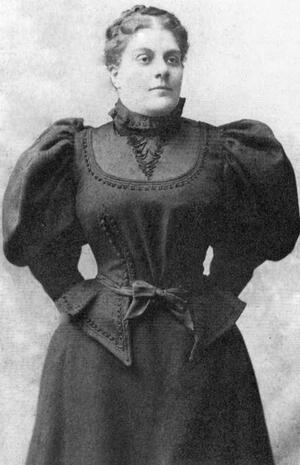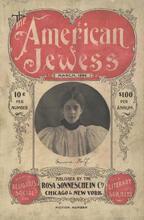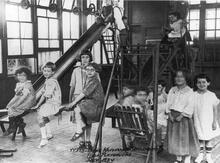Rebekah Bettelheim Kohut
Rebekah Bettelheim Kohut spent her life caring for others. After her husband’s death in 1894, Kohut went to work to support the family, offering lectures on English literature and opening the Kohut College Preparatory School for Girls, which she ran for six years before selling her share of the school to devote more time to her family. During World War I, she worked for various Jewish and secular groups to secure jobs for women in the wartime economy. After the war, she proposed to the National Council of Jewish Women that young women travel to rebuild Jewish communities devastated by the war in Europe, surveying the communities herself before the NCJW sent social workers to rebuild and to teach job skills.
Early Life
Rebekah Bettelheim Kohut made her mark on the American Jewish community in the areas of education, social welfare, and the organization of Jewish women. Grounded in her Jewish identity as the daughter and wife of rabbis, Kohut had a public career that paralleled the beginnings of Jewish women’s activism in the United States.
Rebekah Bettelheim was born in Kaschau, Hungary, on September 9, 1864. Her father, Rabbi Albert Bettelheim, came from a long family tradition of rabbis and doctors. Trained in Hungary as a rabbi, he also took up the study of medicine while serving as a rabbi in Richmond, Virginia. Rebekah’s mother, Henrietta A. Weintraub, was widowed with one son at the time of her marriage to Bettelheim. Together, the couple had one more boy and four girls; Kohut was the third child and third daughter.
Albert Bettelheim’s outspokenness in the midst of political and religious turmoil in Hungary earned him the enmity of many in the Jewish community, and, in 1867, he immigrated with his family to America. He served briefly as a rabbi in Philadelphia before taking a post in 1869 in Richmond, where the family remained for seven years. While in Richmond, Henrietta Bettelheim died, and Albert Bettelheim married a second time and had another daughter.
In 1875, the family moved to San Francisco, where Rebekah graduated from high school and normal school and for two years attended classes at the University of California. Her first entry into social welfare work was with the Fruit and Flower Mission of San Francisco, a non-Jewish association of young women that offered flowers and aid to poor residents of the city. She also worked in San Francisco’s first kindergarten.
Early Career and Family Life
On a trip east in 1886, Rebekah met Alexander Kohut. Having arrived from Hungary in 1885 to serve a New York congregation, Rabbi Kohut was a widower who had become the champion of Jewish traditionalists in the United States. With their marriage on February 14, 1887, Rebekah Kohut became stepmother to his five sons and three daughters, six of whom were under age thirteen. Apart from caring for her new family and doing some limited public speaking, Kohut put most of her energy into facilitating her husband’s scholarly work, maintaining his correspondence, and translating his sermons from German into English.
After the death of her younger brother and her father in 1890, Kohut sought distraction in a more active public life. She participated in the New York’s Women’s Health Protective Association’s campaign for better public sanitation and, drawing upon the example of a new women’s organization at New York’s Temple Emanu-El, she founded the American Jewish community’s second sisterhood at Central Synagogue, the congregation served by her husband. Working with the women of Emanu-El and with other sisterhood groups that soon arose, Central Synagogue’s Sisterhood of Personal Service tried to relieve the hardships faced by the newly arrived Jewish immigrants of New York’s Lower East Side. Alexander Kohut’s failing health added to his wife’s concerns and responsibilities. Although she was invited to deliver a paper at the Jewish Women’s Congress held at the Chicago World’s Fair in 1893, at the last moment Kohut was forced to stay home so that she could look after her husband.
After her husband’s death in 1894, she entered a wide range of public activities. Although her husband’s illness had kept Kohut out of the early planning for the National Council of Jewish Women (NCJW), New York’s Jewish women leaders hoped that the outspoken widow of the Conservative rabbi could calm the religious tensions prevailing among those involved. She accepted their invitation to become president of the newly formed New York section and spoke widely on behalf of the new national organization. Her council work led to an invitation to be the only Jewish woman to speak before a meeting of the national Mother’s Congress in Washington, D.C., presided over by President Grover Cleveland’s wife. Forced into the role of breadwinner for the six young Kohut children, Rebekah Kohut offered a series of lectures on English literature, which she had prepared during the long hours of her husband’s illness, to a regular group of several hundred that gathered at the home of Therese Loeb Schiff. This lecture series continued for many years. Kohut also turned her attention beyond the Jewish community, working with prominent non-Jewish women on the turn-of-the-century mayoral campaigns of Columbia University president Seth Low.
In 1899, after bad investments wiped out her financial security and that of her sisters and stepmother, Kohut opened the Kohut College Preparatory School for Girls. With the help of her stepson George, she successfully oversaw the school until 1905, when she concluded that the responsibilities of running a boarding school demanded too much of her time and separated her from her stepchildren. Investing the profits made in selling the school, Kohut realized a steady income and freed herself from future financial concerns.
Later Career
Kohut re-immersed herself in the world of social service and teaching through work with the Temple Emanu-El sisterhood and the Educational Alliance. When George Kohut established a school for boys in Riverdale in 1907, she served as a housemother to his students. She also helped to create and edit a religious school newspaper, Helpful Thoughts, sponsored by the National Council of Jewish Women.
With her school closed and her stepchildren increasingly independent, Kohut felt the want of a calling. When invited to become a trustee of the Young Women’s Hebrew Association in 1914, she asked to be put in charge of its employment bureau. Heavy demand for the bureau’s services in 1914 and 1915 strengthened Kohut’s commitment to employment work both within and beyond the Jewish community. During World War I, she worked with New York’s Women’s Committee for National Defense to place women in jobs created by the war economy. At the national level, she worked for the Federal Employment Clearing House and served as industrial chair of the National League for Women’s Service. She also sold war bonds and raised money for Jewish war relief.
In 1917, Kohut won support from the NCJW for her proposal to send units of Jewish women abroad to help rebuild the devastated Jewish communities of Europe. Although the proposal failed to gain the support of the principal male-led Jewish relief work organizations, the NCJW named Kohut chair of the Reconstruction Committee and after the war sent her to survey what needed to be done abroad. Upon her recommendation, the council sent social workers to rebuild communities and to teach English and useful skills to those awaiting permission to leave for the United States. The NCJW work in Europe inspired women in many European cities to create council organizations of their own. In 1923, two hundred women from nineteen different countries met in Vienna at the World Congress of Jewish Women, where they formed an ongoing organization and elected Rebekah Kohut president.
Kohut’s work with the devastated Jewish communities of Europe took its toll upon her health. Forced to take a leave from active life in 1924, Kohut used the opportunity to compose her memoirs, My Portion. Once her strength returned, she reentered the public arena, notably in the area of employment work. In 1931, New York governor Franklin D. Roosevelt appointed her to the state’s Advisory Council on Employment and, in 1932, to the advisory commission of the New York State Employment Service. From 1932 to 1933, she served as the sole female member of the Joint Legislative Committee on Unemployment and the only member to call for the immediate establishment of state unemployment insurance.
When her stepson George died in 1933, Kohut took his place as executive director of the Columbia Grammar School, guiding the school for two more years. In 1935, she was honored by eight hundred of New York’s philanthropic and political elite, who gathered to celebrate her fifty years of service in social and educational work and presented her with $50,000 to distribute to those causes most dear to her. In 1934, she received an honorary doctorate from the Jewish Institute of Religion.
After suffering a broken hip, Kohut was bedridden for the last seven years of her life. During her confinement, she wrote another memoir, More Yesterdays, published in 1950, which reflected upon her life and the experience of old age. Rebekah Bettelheim Kohut died on August 11, 1951, in New York City.
As founder of one the first synagogue sisterhoods and as an early leader in the National Council of Jewish Women, Rebekah Kohut emerged as a public figure at the same time that Jewish women’s activism took hold in American Jewish life. Despite recurrent tensions between the demands of public and private life, she helped to create frameworks that systematically brought acculturated American Jewish women into the philanthropic, religious, and educational work of the American Jewish community.
Selected Works by Rebekah Kohut
As I Know Them: Some Jews and a Few Gentiles (1929).
His Father’s House: The Story of George Alexander Kohut (1938).
More Yesterdays (1950); My Portion (1925).
AJYB 7 (1905–1906): 76, 24:1164, 54:539.
Antler, Joyce. The Journey Home: Jewish Women and the American Century (1997).
BEOAJ.
EJ.
Kohut, Rebekah. Papers. AJA, Cincinnati, Ohio, and American Jewish Historical Society, Waltham, Mass.
Kuzmack, Linda Gordon. Woman’s Cause: The Jewish Woman’s Movement in England and the United States, 1881–1935 (1993).
NAW modern; Obituary. NYTimes August 12, 1951, 79.
Rogow, Faith. Gone to Another Meeting: The National Council of Jewish Women, 1893–1993 (1993).
UJE.
WWIAJ (1926, 1928, 1938).





